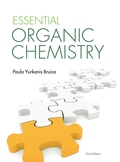
Concept explainers
(a)
Interpretation:
The number of signals expected in the
Concept Introduction:
It is the study of the interaction between
Chemical equivalence:
The number of different kinds of protons in different electronic environments causes the number of signals in a
If the protons are in identical electronic environments, then they are said to be chemically equivalent and they produce only one signal.
(b)
Interpretation:
The number of signals expected in the
Concept Introduction:
It is the study of the interaction between electromagnetic radiation and the nuclei of hydrogen atoms and the hydrogen atoms.
Chemical equivalence:
It is the study of the interaction between electromagnetic radiation and the nuclei of hydrogen atoms and the hydrogen atoms
If the protons are in identical electronic environments, then they are said to be chemically equivalent and they produce only one signal.
(c)
Interpretation:
The number of signals expected in the
Concept Introduction:
It is the study of the interaction between electromagnetic radiation and the nuclei of hydrogen atoms and the hydrogen atoms.
Chemical equivalence:
The number of different kinds of protons in different electronic environments causes the number of signals in a
If the protons are in identical electronic environments, then they are said to be chemically equivalent and they produce only one signal.
(d)
Interpretation:
The number of signals expected in the
Concept Introduction:
It is the study of the interaction between electromagnetic radiation and the nuclei of hydrogen atoms and the hydrogen atoms.
Chemical equivalence:
The number of different kinds of protons in different electronic environments causes the number of signals in a
If the protons are in identical electronic environments, then they are said to be chemically equivalent and they produce only one signal.
(e)
Interpretation:
The number of signals expected in the
Concept Introduction:
It is the study of the interaction between electromagnetic radiation and the nuclei of hydrogen atoms and the hydrogen atoms.
Chemical equivalence:
The number of different kinds of protons in different electronic environments causes the number of signals in a
If the protons are in identical electronic environments, then they are said to be chemically equivalent and they produce only one signal.
(f)
Interpretation:
The number of signals expected in the
Concept Introduction:
It is the study of the interaction between electromagnetic radiation and the nuclei of hydrogen atoms and the hydrogen atoms.
Chemical equivalence:
The number of different kinds of protons in different electronic environments causes the number of signals in a
If the protons are in identical electronic environments, then they are said to be chemically equivalent and they produce only one signal.
Want to see the full answer?
Check out a sample textbook solution
Chapter 10 Solutions
EBK ESSENTIAL ORGANIC CHEMISTRY
- X Draw the major products of the elimination reaction below. If elimination would not occur at a significant rate, check the box under the drawing area instead. ది www. Cl + OH Elimination will not occur at a significant rate. Click and drag to start drawing a structure.arrow_forwardNonearrow_forward1A H 2A Li Be Use the References to access important values if needed for this question. 8A 3A 4A 5A 6A 7A He B C N O F Ne Na Mg 3B 4B 5B 6B 7B 8B-1B 2B Al Si P 1B 2B Al Si P S Cl Ar K Ca Sc Ti V Cr Mn Fe Co Ni Cu Zn Ga Ge As Se Br Kr Rb Sr Y Zr Nb Mo Tc Ru Rh Pd Ag Cd In Sn Sb Te I Xe * Cs Ba La Hf Ta W Re Os Ir Pt Au Hg Tl Pb Bi Po At Rn Fr Ra Ac Rf Ha ****** Ce Pr Nd Pm Sm Eu Gd Tb Dy Ho Er Tm Yb Lu Th Pa U Np Pu Am Cm Bk Cf Es Fm Md No Lr Analyze the following reaction by looking at the electron configurations given below each box. Put a number and a symbol in each box to show the number and kind of the corresponding atom or ion. Use the smallest integers possible. cation anion + + Shell 1: 2 Shell 2: 8 Shell 3: 1 Shell 1 : 2 Shell 2 : 6 Shell 1 : 2 Shell 2: 8 Shell 1: 2 Shell 2: 8arrow_forward
 ChemistryChemistryISBN:9781305957404Author:Steven S. Zumdahl, Susan A. Zumdahl, Donald J. DeCostePublisher:Cengage Learning
ChemistryChemistryISBN:9781305957404Author:Steven S. Zumdahl, Susan A. Zumdahl, Donald J. DeCostePublisher:Cengage Learning ChemistryChemistryISBN:9781259911156Author:Raymond Chang Dr., Jason Overby ProfessorPublisher:McGraw-Hill Education
ChemistryChemistryISBN:9781259911156Author:Raymond Chang Dr., Jason Overby ProfessorPublisher:McGraw-Hill Education Principles of Instrumental AnalysisChemistryISBN:9781305577213Author:Douglas A. Skoog, F. James Holler, Stanley R. CrouchPublisher:Cengage Learning
Principles of Instrumental AnalysisChemistryISBN:9781305577213Author:Douglas A. Skoog, F. James Holler, Stanley R. CrouchPublisher:Cengage Learning Organic ChemistryChemistryISBN:9780078021558Author:Janice Gorzynski Smith Dr.Publisher:McGraw-Hill Education
Organic ChemistryChemistryISBN:9780078021558Author:Janice Gorzynski Smith Dr.Publisher:McGraw-Hill Education Chemistry: Principles and ReactionsChemistryISBN:9781305079373Author:William L. Masterton, Cecile N. HurleyPublisher:Cengage Learning
Chemistry: Principles and ReactionsChemistryISBN:9781305079373Author:William L. Masterton, Cecile N. HurleyPublisher:Cengage Learning Elementary Principles of Chemical Processes, Bind...ChemistryISBN:9781118431221Author:Richard M. Felder, Ronald W. Rousseau, Lisa G. BullardPublisher:WILEY
Elementary Principles of Chemical Processes, Bind...ChemistryISBN:9781118431221Author:Richard M. Felder, Ronald W. Rousseau, Lisa G. BullardPublisher:WILEY





